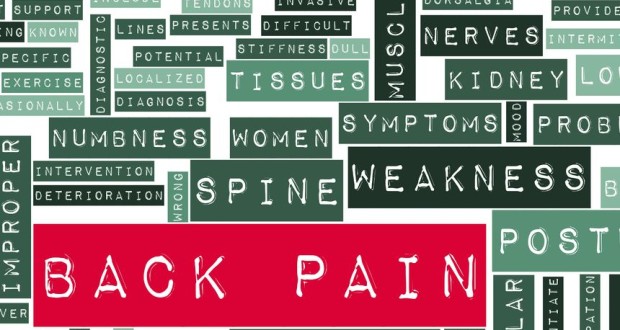Along with wrinkles and graying hair, back pain is often considered one of the sobering signs of getting older. You’ve probably heard at least one person complain about his or her persistent back problems, and at times it may seem if back problems are all but inevitable for most people. There is a good amount of truth to such sentiment; it is estimated that roughly 80 percent of adults will deal with back pain at some point in their lives. Given that so many of us deal with back problems, studying some preventative strategies and techniques could be quite useful.
Some Reasons for Back Pain
While some medical conditions are caused by external factors, back pain is often a self-inflicted problem. The back can be damaged either through excessively taxing physical activity, or though a thoroughly sedentary lifestyle. The proceeding list helps explain why back pain bothers so many people.
Asking Too Much From the Back – Often times, someone who is out of shape (or at least unaccustomed to demanding physical exercise) will attempt to channel their inner sports superstar while playing a game of pick-up hoops or weekend baseball. This frequently doesn’t end well, as the back’s seldom-used muscles are suddenly asked to handle a heavy workload, leading to muscle sprains and other injuries.
Poor Lifting Technique – See if this sounds familiar – you bend over to pick up something heavy, and on the way back up you feel a sharp pain in your back. Yep, improper lifting techniques are responsible for a countless number of back injuries. The next time you have to lift up a heavy object, bend your knees so that you’re squatting next to the object. Try to keep your back straight, and remember to hold the object close to you as you lift it upwards.
Too Much Sitting – For many workers, a typical workday goes something like this; a prolonged commute to the office while sitting in a car, followed by sitting in front of computer monitor for the better part of eight hours, followed by more sitting for the commute home and ending with sitting, slouching or lying down on the living room couch.
All of that sitting isn’t good for your back. Believe or not, sitting places twice as much of a burden on your back than standing. Many people compound this problem by slouching, which further exacerbates the pressure placed on the spine.
Another problem with sitting is that it deprives key parts of the spine of vital nutrients. In between the individual vertebrae that make up your spine are discs, rubbery pads that prevent the vertebrae from grinding against each other. The blood circulation to these disks is very poor, a design flaw that can only be circumvented by getting up and walking around. When the body is parked in a sitting position, the supply of nutrients to the spinal discs dries up.
Wear, Tear and Aging – Like every other part of the body, the discs that buffer the vertebrae can wither and deteriorate with age. Consequentially, the individual vertebrae begin to grind up against each other, causing the back to become stiff and painful. In addition, a significant number of older adults develop osteoporosis, a chronic condition that leaves bones brittle and weak. Vertebrae weakened by osteoporosis are more likely to suffer from compression fractures, which cause vertebrae to crack and compress inward.
Preserving Your Back
Back pain isn’t entirely unavoidable; in fact, by following some easy-to-implement guidelines, you can help keep your back in relatively good condition.
Stop the Slouching – Remember when your parents chastised you for your poor posture? They were doing you a favor; a slouching habit can trigger muscle pains in your back, and a study by San Francisco State University linked poor posture to a greater risk of depression. To maintain proper posture when standing, the Mayo Clinic recommends keeping your shoulders back, pulling your abdomen inward and positioning your feet roughly hip distance apart.
Sit Up Straight – Here’s another piece of parental advice that is still useful in adulthood. While sitting, your back should be straight and you buttocks should be firmly pressed against your chair. Both shoulders should be in a relaxed position, and it would be best for the knees and hips to be at an even level. It is also acceptable for the knees to be slightly positioned above the hips. When working at a desk, make sure to set your chair to the appropriate height; this will allow you to work without slouching or hunching.
Be Care When Lifting Heavy Objects – We’ve already discussed how to properly lift a heavy object off the ground. However, it’s important to know your limits. There will be some items that will simply be too heavy for you to lift without risking injury.
Exercise Your Back – When hitting the weight room, some people overlook their back in favor of their chest, bicep or tricep muscles. While there are certain weight machines that focus on the back muscles – including lat pulldown and back extension machines – you can also bolster your back muscles with free weights. Certain yoga poses can also strengthen the back.
Give Up Your Smokes – What’s this? Quitting smoking might help your back? Strange as this correlation may sound, there is plenty of evidence that indicates it is true. A 2010 Finnish study, for example, compared the incidence of lower back pain between smokers and non-smokers. Compared with people who had never smoked, habitual smokers had a greater tendency to report pain in the lower back area.
Boost Your Bones Through Diet – A seemingly healthy back can be undermined by weak bones, which are prone to painful fractures. Consuming appropriate amounts of calcium and vitamin D can help keep the spine strong, reducing its risk of injury.
 Natural Knowledge 24/7 Educate yourself with nutrition, health and fitness knowledge.
Natural Knowledge 24/7 Educate yourself with nutrition, health and fitness knowledge.






